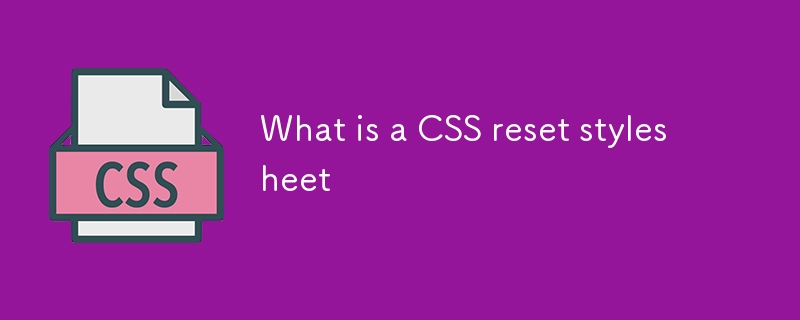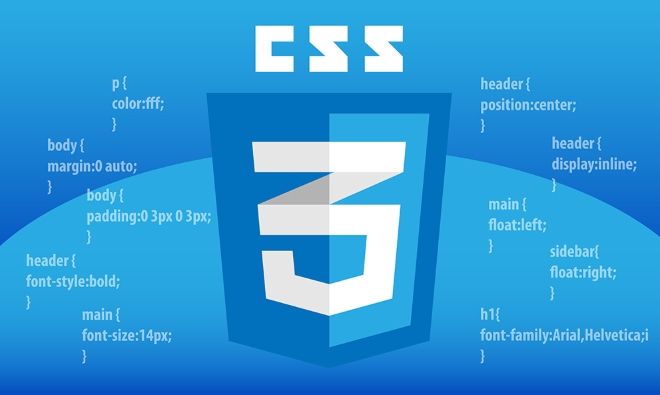CSS reset ensures that web pages display consistently in different browsers by resetting the browser's default style. Browser default style differences will affect the layout, such as title margins, paragraph line heights, etc. CSS reset can eliminate these differences, improve style consistency, and reduce debugging time. Common methods include: 1. The basic reset uses wildcard selector to reset the margin and padding of all elements, but may affect performance; 2. Eric Meyer Reset lists specific elements for more granular control, suitable for large projects; 3. Normalize.css does not completely clear the style but uniformly repairs the default style, suitable for situations where you want to retain useful default styles. The selection method depends on the project type: wildcard reset is available for small projects, Eric Meyer Reset or Normalize.css is recommended for medium and large projects. When using CSS frameworks, there is usually no need to introduce additional resets.

CSS reset stylesheet is a way to ensure that web pages appear consistently in different browsers by resetting the browser's default style. By default, each browser has subtle differences in the style processing of HTML elements, such as the upper and lower margins of the title, the line height of the paragraph, the indentation of the list, etc. If not uniformly processed, these differences may cause the page to look different in different browsers.

The core goal of a CSS reset stylesheet is to "clear" these default styles, allowing developers to start designing from a more "clean" starting point rather than debugging various unexpected style issues in different browsers.
Why do I need a CSS reset?
In order to improve user experience, the browser will add some default styles to HTML elements. For example, Chrome may add 21px margin to the <h1></h1> tag, while Firefox may be 20px. These differences may have affected the page layout without you noticing them.

Using CSS reset can:
- Eliminate browser default style differences
- Improve style consistency, especially in layout, margins, font size, etc.
- Reduce cross-browser debugging time
Common reset methods include setting the margin and padding of all elements to 0, clearing the list style, uniform font size, etc.

Common CSS reset methods
1. The most basic way to write reset
* {
margin: 0;
padding: 0;
box-sizing: border-box;
} This is a very common way to write it, using wildcard selector * to reset margin and padding for all elements. box-sizing: border-box; is to make the width of the element include padding and border, so that it is easier to control the size when laying out.
However, this writing has a disadvantage: it affects all elements, including pseudo-elements, and can cause performance problems, especially in large projects.
2. More fine reset (such as Eric Meyer Reset)
html, body, div, span, applet, object, iframe,
h1, h2, h3, h4, h5, h6, p, blockquote, pre,
abbr, acronym, address, big, cite, code,
del, dfn, em, img, ins, kbd, q, s, samp,
small strike strong sub sup tt var
b, u, i, center,
dl, dt, dd, ol, ul, li,
fieldset, form, label, legend,
table, caption, tbody, tfoot, thead, tr, th, td,
article, aside, canvas, details, embedded,
figure, figcaption, footer, header, hgroup,
menu, nav, output, ruby, section, summary,
time, mark, audio, video {
margin: 0;
padding: 0;
border: 0;
font-size: 100%;
font: inherit;
vertical-align: baseline;
}This is the classic Eric Meyer Reset that explicitly lists all common HTML elements and resets their styles. This method is more controllable and more suitable for large-scale projects.
3. Use Normalize.css
Unlike reset, Normalize.css does not completely clear the style, but makes the browser's default style more consistent and modern. For example, it will fix some bugs and unify the default style of HTML5 elements, rather than simply and roughly clear all of them.
Normalize is a good choice if you want to keep some useful default styles (such as <sup></sup> and <sub></sub> typesettings) while also wanting to eliminate browser differences.
How to choose the reset method that suits you?
There is no standard answer to this question, mainly depends on your project type and development habits:
- If it's a small project or a rapid prototype: use wildcard reset (
* { margin: 0; padding: 0 }) enough - If it is a medium-sized project or pursues precise control: it is recommended to use Eric Meyer Reset or similar methods
- If you want to keep the default style and want to unify behavior: use Normalize.css
- If you use CSS frameworks (such as Tailwind CSS, Bootstrap): they usually come with reset or base styles and do not require additional introductions
A practical suggestion is: first understand the problems caused by the default style differences, and then decide whether reset is really needed. Some projects do not actually need to reset all elements, and resetting only key parts (such as titles, paragraphs, lists) is enough.
Basically that's it.
The above is the detailed content of What is a CSS reset stylesheet. For more information, please follow other related articles on the PHP Chinese website!

Hot AI Tools

Undress AI Tool
Undress images for free

Undresser.AI Undress
AI-powered app for creating realistic nude photos

AI Clothes Remover
Online AI tool for removing clothes from photos.

Clothoff.io
AI clothes remover

Video Face Swap
Swap faces in any video effortlessly with our completely free AI face swap tool!

Hot Article

Hot Tools

Notepad++7.3.1
Easy-to-use and free code editor

SublimeText3 Chinese version
Chinese version, very easy to use

Zend Studio 13.0.1
Powerful PHP integrated development environment

Dreamweaver CS6
Visual web development tools

SublimeText3 Mac version
God-level code editing software (SublimeText3)
 CSS tutorial for creating loading spinners and animations
Jul 07, 2025 am 12:07 AM
CSS tutorial for creating loading spinners and animations
Jul 07, 2025 am 12:07 AM
There are three ways to create a CSS loading rotator: 1. Use the basic rotator of borders to achieve simple animation through HTML and CSS; 2. Use a custom rotator of multiple points to achieve the jump effect through different delay times; 3. Add a rotator in the button and switch classes through JavaScript to display the loading status. Each approach emphasizes the importance of design details such as color, size, accessibility and performance optimization to enhance the user experience.
 Addressing CSS Browser Compatibility issues and prefixes
Jul 07, 2025 am 01:44 AM
Addressing CSS Browser Compatibility issues and prefixes
Jul 07, 2025 am 01:44 AM
To deal with CSS browser compatibility and prefix issues, you need to understand the differences in browser support and use vendor prefixes reasonably. 1. Understand common problems such as Flexbox and Grid support, position:sticky invalid, and animation performance is different; 2. Check CanIuse confirmation feature support status; 3. Correctly use -webkit-, -moz-, -ms-, -o- and other manufacturer prefixes; 4. It is recommended to use Autoprefixer to automatically add prefixes; 5. Install PostCSS and configure browserslist to specify the target browser; 6. Automatically handle compatibility during construction; 7. Modernizr detection features can be used for old projects; 8. No need to pursue consistency of all browsers,
 What is the difference between display: inline, display: block, and display: inline-block?
Jul 11, 2025 am 03:25 AM
What is the difference between display: inline, display: block, and display: inline-block?
Jul 11, 2025 am 03:25 AM
Themaindifferencesbetweendisplay:inline,block,andinline-blockinHTML/CSSarelayoutbehavior,spaceusage,andstylingcontrol.1.Inlineelementsflowwithtext,don’tstartonnewlines,ignorewidth/height,andonlyapplyhorizontalpadding/margins—idealforinlinetextstyling
 Styling visited links differently with CSS
Jul 11, 2025 am 03:26 AM
Styling visited links differently with CSS
Jul 11, 2025 am 03:26 AM
Setting the style of links you have visited can improve the user experience, especially in content-intensive websites to help users navigate better. 1. Use CSS's: visited pseudo-class to define the style of the visited link, such as color changes; 2. Note that the browser only allows modification of some attributes due to privacy restrictions; 3. The color selection should be coordinated with the overall style to avoid abruptness; 4. The mobile terminal may not display this effect, and it is recommended to combine it with other visual prompts such as icon auxiliary logos.
 Creating custom shapes with css clip-path
Jul 09, 2025 am 01:29 AM
Creating custom shapes with css clip-path
Jul 09, 2025 am 01:29 AM
Use the clip-path attribute of CSS to crop elements into custom shapes, such as triangles, circular notches, polygons, etc., without relying on pictures or SVGs. Its advantages include: 1. Supports a variety of basic shapes such as circle, ellipse, polygon, etc.; 2. Responsive adjustment and adaptable to mobile terminals; 3. Easy to animation, and can be combined with hover or JavaScript to achieve dynamic effects; 4. It does not affect the layout flow, and only crops the display area. Common usages are such as circular clip-path:circle (50pxatcenter) and triangle clip-path:polygon (50%0%, 100 0%, 0 0%). Notice
 How to create responsive images using CSS?
Jul 15, 2025 am 01:10 AM
How to create responsive images using CSS?
Jul 15, 2025 am 01:10 AM
To create responsive images using CSS, it can be mainly achieved through the following methods: 1. Use max-width:100% and height:auto to allow the image to adapt to the container width while maintaining the proportion; 2. Use HTML's srcset and sizes attributes to intelligently load the image sources adapted to different screens; 3. Use object-fit and object-position to control image cropping and focus display. Together, these methods ensure that the images are presented clearly and beautifully on different devices.
 Demystifying CSS Units: px, em, rem, vw, vh comparisons
Jul 08, 2025 am 02:16 AM
Demystifying CSS Units: px, em, rem, vw, vh comparisons
Jul 08, 2025 am 02:16 AM
The choice of CSS units depends on design requirements and responsive requirements. 1.px is used for fixed size, suitable for precise control but lack of elasticity; 2.em is a relative unit, which is easily caused by the influence of the parent element, while rem is more stable based on the root element and is suitable for global scaling; 3.vw/vh is based on the viewport size, suitable for responsive design, but attention should be paid to the performance under extreme screens; 4. When choosing, it should be determined based on whether responsive adjustments, element hierarchy relationships and viewport dependence. Reasonable use can improve layout flexibility and maintenance.
 What are common CSS browser inconsistencies?
Jul 26, 2025 am 07:04 AM
What are common CSS browser inconsistencies?
Jul 26, 2025 am 07:04 AM
Different browsers have differences in CSS parsing, resulting in inconsistent display effects, mainly including the default style difference, box model calculation method, Flexbox and Grid layout support level, and inconsistent behavior of certain CSS attributes. 1. The default style processing is inconsistent. The solution is to use CSSReset or Normalize.css to unify the initial style; 2. The box model calculation method of the old version of IE is different. It is recommended to use box-sizing:border-box in a unified manner; 3. Flexbox and Grid perform differently in edge cases or in old versions. More tests and use Autoprefixer; 4. Some CSS attribute behaviors are inconsistent. CanIuse must be consulted and downgraded.






